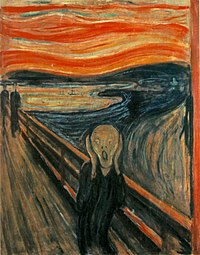
Photo from wikipedia
The Screen for Child Anxiety and Related Emotional Disorder (SCARED) may be differentially sensitive to detecting specific or comorbid anxiety diagnoses in treatment-seeking and non-treatment-seeking youth. We assessed the SCARED's… Click to show full abstract
The Screen for Child Anxiety and Related Emotional Disorder (SCARED) may be differentially sensitive to detecting specific or comorbid anxiety diagnoses in treatment-seeking and non-treatment-seeking youth. We assessed the SCARED's discriminant validity, diagnostic utility, and informant agreement using parent- and self-report from healthy and treatment-seeking anxious youth (Study 1, N=585) and from non-treatment-seeking anxious youth (Study 2, N=331) diagnosed with generalized anxiety disorder (GAD), social anxiety disorder (SAD), or comorbid GAD+SAD. Among treatment-seeking youth, the SCARED showed good diagnostic utility and specificity, differentiating healthy, comorbid, and non-comorbid anxious youth. Child-parent agreement was modest: healthy child self-reports were higher than parent-reports whereas anxious child self-reports were similar or lower than parent-reports. Less consistent results emerged for diagnostic utility, specificity, and informant agreement among non-treatment-seeking youth. Given the number of non-treatment seeking anxious youth (N=33), generalizability of these findings may be limited. Together, results suggest informants may provide distinct information about children's anxiety symptoms.
Journal Title: Journal of anxiety disorders
Year Published: 2017
Link to full text (if available)
Share on Social Media: Sign Up to like & get
recommendations!